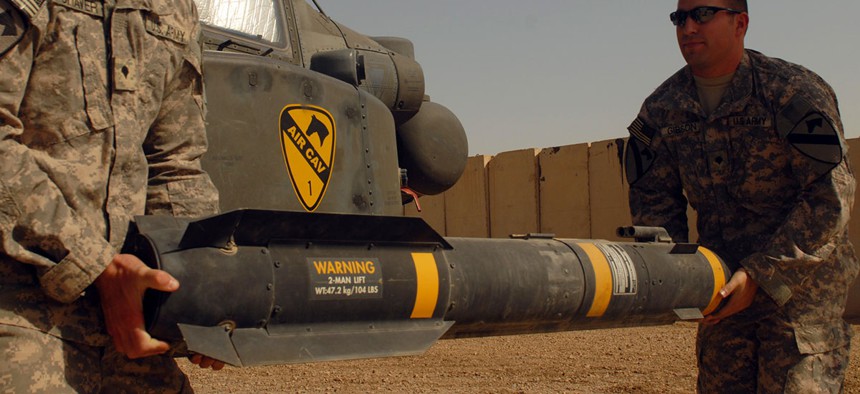
Spc. Scott Shaver (left) and Spc. Bret Gibson, haul a Hellfire missile to load onto the mounting bracket of an AH-64D Apache helicopter in 2009 Defense Department file photo
Lockheed Expanding Missile Factories, Quadruples Bomb Production for ISIS Long Haul
The Hellfire maker is boosting production for an era of conflict with no end in sight.
Lockheed Martin is expanding various munition factories to meet rising demand from the U.S. and its partners fighting the Islamic State — and to start equipping American warplanes for great-power wars at sea.
“We are seeing a lot of international demand for our product set,” Frank St. John, Lockheed’s vice president of tactical missiles, said Tuesday. “That’s causing us to do a lot of work in international partnerships and co-production and we’re very excited about those opportunities.”
In particular, U.S. and allies are burning through their stocks of Lockheed’s Hellfire missile, the signature weapon of Predator and Reaper drones. Helicopters and fixed-wing planes also carry the versatile laser-guided weapon.
“It requires a little bit of investment on our part to expand the factories, but the demand is there and we’re keeping up with it [and] we’re staying ahead of it,” St. John said.
It also requires Pentagon funding. Last June, the U.S. Army gave Lockheed $18 million to boost Hellfire production from 500 to 650 missiles per month. St. John said the company has added tools, test equipment, and floor space to its Hellfire production line.
Lockheed has also “quadrupled our production capacity” at the Archbald, Pennsylvania, factory to meet demand from the U.S. and its allies for Paveway II laser-guided bombs.
With top military officials predicting that the ISIS campaign will run for years, demand for missiles and bombs is expected to remain high.
“I don’t see events in the world changing dramatically over the next couple of years,” St. John said. “[T]he conflicts that are requiring the use of our systems are lingering, so anticipate that we’ll be producing at a pretty high level for some period of time.”
Between August 2014 and February 2016, the latest month for which Pentagon data is available, American warplanes dropped more than 39,715 bombs, worth some $1.5 billion, on ISIS targets in Iraq and Syria. Last month, Defense Secretary Ash Carter said he had asked Congress for $1.8 billion to buy 45,000 smart bombs in fiscal 2017. In all, the Pentagon plans to spend $1.89 billion on JDAM, Hellfire, and Small Diameter bombs next year, up $337 million for those three weapons this year.
On Wednesday, Air Force Secretary Deborah Lee James told the House Armed Services Committee, “We … need to invest more in munitions.”
NATO and Middle Eastern allies are also believed to want to buy these weapons, Roman Schweizer, an analyst with Guggenheim, said in a March 7 note to investors. Saudi Arabia, United Arab Emirates, Bahrain, and Jordan have all struck ISIS targets in Syria.
Meanwhile, Lockheed is also preparing to build a new generation of weapons that might fight future wars. The firm has added 60,000 square feet to the Troy, Alabama, factory where it builds the Joint Air-to-Surface Standoff Missile, a stealthy cruise missile, St. John said. That expansion will make room to build 110 Long-Range Anti-Ship Missiles, now under development for Navy Super Hornet fighters and Air Force B-1B bombers.







